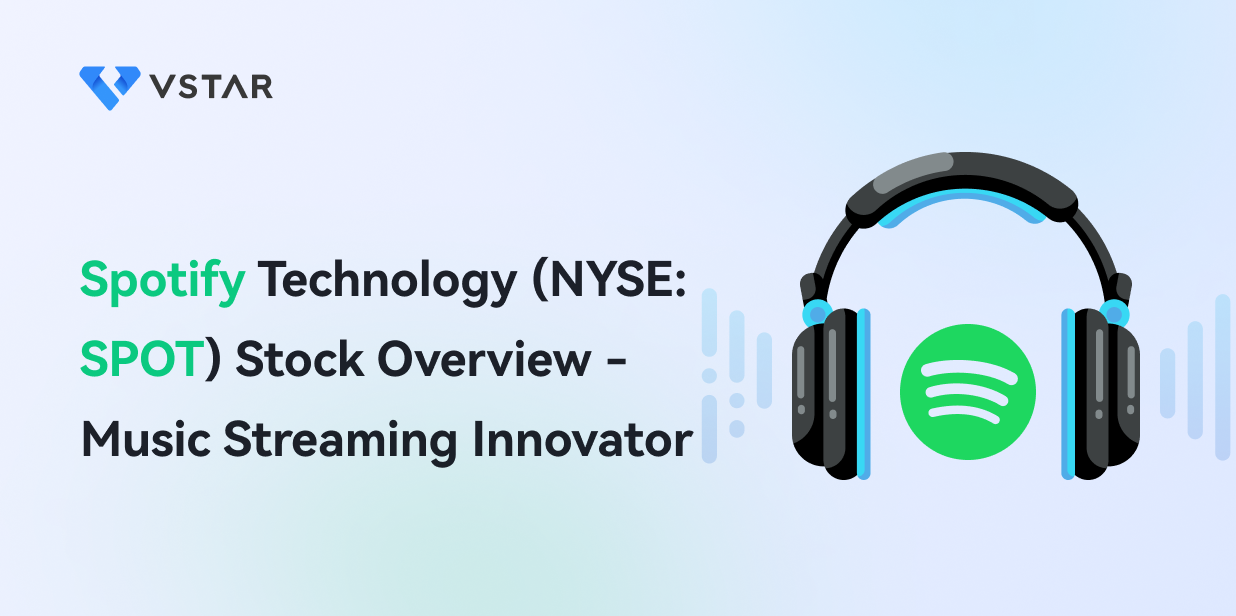Are you considering trading Spotify stock? If you are, then this article is perfect for you! In this post, we’ll delve into an exhaustive analysis of Spotify's stock, considering its journey from the day of the Spotify IPO. We’ll offer a comprehensive view of the SPOT stock's performance since then. We’ll also answer questions like, “Is the Spotify stock a buy or sell? What's the current Spotify stock forecast, and what does the Spotify price target look like?
So read on to learn everything you need to know about Spotify stock and valuation!
Latest Spotify Stock News and Developments You Should Be Aware Of
To start, let’s look at some current developments and Spotify stock news you should be aware of as a trader or an investor.
Spotify stock is currently enjoying a very strong start to 2023 following a tough 2022 for investors from a stock value crash that dates back to October 1, 2021. However, Spotify's stock price has been struggling to maintain its upward momentum recently. These problems started after Spotify doubled down on its podcast services, a move that has not been as successful as the company projected.
Because of this, Spotify recently announced that it would reduce its podcast workforce to cut costs and boost profits. This current cut accounts for about 2% of its workforce and follows an earlier 6% cut that took place early this year.
Why Is Spotify Stock Worth Trading?

Credit: iStock
If you’re currently considering trading Spotify stock, you may be wondering, “Is Spotify stock a good investment?” Or maybe you’re thinking, “What is the growth potential of Spotify stock?” You should know that based on recent news and analysis, Spotify stock remains a very strong buy. In the later parts of this post, we’ll cover every angle of why you should consider buying Spotify stock.
Spotify Technology's Overview
Spotify Technology was founded in April 2006 by Daniel Ek and Martin Lorentzon in Stockholm, Sweden. The duo sought to create a legal digital platform for music in response to the growing piracy issue plaguing the industry. After two years of development, Spotify was officially launched to the public on October 7, 2008.

Credit: iStock
Some of the key milestones in Spotify's history include:
● 2008: Public launch in several European countries with a freemium model.
● 2011: Launch in the United States after striking crucial deals with major record labels.
● 2013: Spotify reaches 24 million active users and 6 million paying subscribers.
● 2015: Introduction of new features such as video content, podcasts, and a running feature that matched music to the tempo of a user's run.
● 2018: Spotify goes public via a direct listing on the New York Stock Exchange under the ticker symbol 'SPOT'.
● 2019: Acquisition of podcast companies Gimlet Media, Anchor FM, and Parcast as part of a strategic move towards becoming an "audio-first" platform.
● 2020: Spotify hits 345 million monthly active users and 155 million premium subscribers.
The current CEO of Spotify is one of its co-founders, Daniel Ek. Ek, born in Stockholm, Sweden, has a background in engineering and was an entrepreneur from a young age. Before Spotify, he founded Advertigo, an online advertising company, which he later sold. Under his leadership, Spotify has grown to become one of the world's leading audio streaming platforms.
Spotify Technology's Business Model and Products/Services

Credit: iStock
Spotify operates under a freemium business model, which includes both free, ad-supported services and premium subscription-based services. This two-tiered model has been instrumental in its growth and success.
Premium Subscriptions: This is the primary source of Spotify's revenue. Premium subscribers pay a monthly fee for an ad-free listening experience. They also gain access to additional features such as offline listening and higher-quality audio streaming. Subscriptions come in several tiers, including individual, family, and student plans, each with different price points.
Ad-Supported Services: Spotify offers a free service where users listen to music interspersed with advertisements. Revenue comes from marketers who pay Spotify to play their ads to these non-premium users. The ad-supported service is a funnel to convert free listeners to paid subscribers.
Partnerships: Spotify also generates income through partnerships with other companies. For example, certain phone and internet service providers bundle Spotify Premium with their services, introducing a new revenue stream for Spotify.
Main Products/Services
Spotify's main service is its audio streaming platform, which provides access to a vast library of music tracks and podcasts. Users can browse by parameters such as artist, album, genre, or playlist, and they can create share, and edit playlists.
Some other main products include the following:
Spotify Connect: Spotify Connect is part of its premium offering, which allows users to stream their music on various connected devices like speakers, TVs, and cars.
Podcasting: Spotify has increasingly become invested in podcasting, procuring exclusive rights to numerous popular podcasts.
Spotify for Artists: Spotify for Artists is a platform that provides analytics and tools to musicians and record labels to monitor performance and engage with their audience.
Spotify also offers a self-serve audio advertisement platform known as Spotify Ad Studio.
Spotify Technology's Financials, Growth, and Valuation Metrics
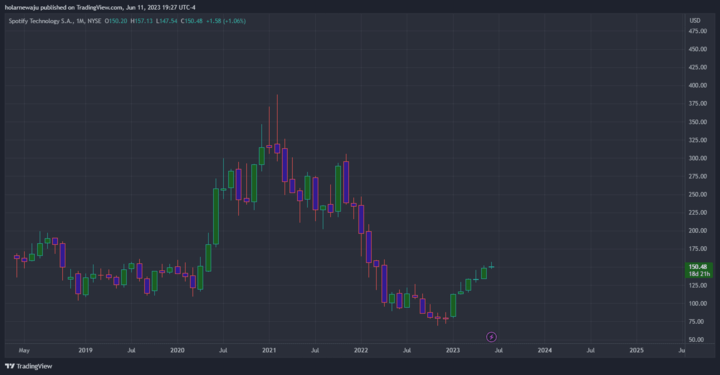
Credit: Tradingview
The past five years witnessed a wild rollercoaster for Spotify stock prices, with an exciting price surge followed by a steep plunge. On February 16, 2021, Spotify stock hit a five-year average high of 364.59. This pinnacle, however, gave way to a severe decline that dropped the stock price well beyond its recent low of 122.54, bottoming out at 74.74 on December 12, 2022. Spotify stock has steadily climbed and now hovers around the 150.48 price level. Spotify currently has a market cap of 29.11B.
In terms of revenue, 2022 was a fruitful year for Spotify, yielding 11.73 billion - marking a robust growth of 21.30% from 9.67 billion the previous year. However, losses also showed a 1164.7% increase, more than in 2021.
In the first quarter of 2023, Spotify saw its cash flow from operating activities grow by 52.53% year-over-year, amounting to $0.063B. Yet, if we examine the broader picture of the twelve months ending March 31, 2023, cash flow from operating activities has declined by 65.51%, standing at $0.310B. As of March 31, 2023, Spotify's net profit margin sits at -6.49%, with an EBITDA margin of -5.29%.
At present, the real value of Spotify Technology stock is $162.3 per share, which stands above its current trading price of $150.48. This discrepancy suggests that the company's shares are currently undervalued.
SPOT Stock trading information

Credit: iStock
Spotify Technology S.A. conducted its initial public offering (IPO) on April 3, 2018. In a unique move, the company chose a direct listing. The shares trade on the New York Stock Exchange (NYSE) under the SPOT ticker. Being listed on the NYSE, the company's shares trade in U.S. dollars.
Like other NYSE-listed stocks, Spotify's shares trade from 9:30 AM to 4:00 PM Eastern Time (ET) during regular market hours. There's also the option to trade during pre-market and after-market hours. Pre-market trading typically occurs from 4:00 AM to 9:30 AM ET, and after-market trading extends from 4:00 PM to 8:00 PM ET.
It is worth mentioning that since its listing, Spotify stock hasn’t undergone any stock splits. Also, Spotify does not currently offer a dividend to its shareholders.
Key Drivers Of SPOT Stock

Credit: iStock
If you’re looking to invest in SPOT stock, then you should know there are several critical drivers that can influence the price of Spotify Technology's stock (SPOT). The main ones include the following:
Subscriber Growth: Spotify's primary source of revenue is its premium subscribers. Therefore, the company's ability to continue adding subscribers robustly can positively drive its stock price.
Ad Revenue: Spotify has been increasingly monetizing its free users through advertisements. As such, ad revenue growth is another key driver for SPOT stock.
Operating Costs: Spotify's costs, particularly royalty payments to music rights holders, are a significant part of its business model. How well Spotify can manage these costs could significantly impact its profitability and, thus, its stock price.
Competition:The level of competition in the music streaming industry can also influence SPOT stock. This includes competition from large, well-funded companies like Apple and Amazon.
Market Sentiment: As with any stock, market sentiment plays a role in Spotify's stock price. This includes investor attitudes towards tech stocks more generally and more specific issues, like data privacy.
Future Prospects and Forecast for SPOT Stock
The future outlook for Spotify Technology is favorable, propelled by the expanding global demand for music streaming services. Spotify's ongoing dedication to refining the user experience, pioneering new markets, and implementing groundbreaking features to maintain a competitive edge indicates a promising growth trajectory.
Although Spotify has yet to turn a profit, it has successfully narrowed its losses by an annual rate of 20.4% over the previous five years. Projections for Spotify Technology show promising trends with expected earnings growth of 71.1% and revenue growth of 11.4% annually. Furthermore, it's anticipated that Earnings Per Share (EPS) will surge by 74.1%. By the three-year mark, the company's Return on Equity (ROE) is predicted to reach 15.6%.
Risks/Challenges and Opportunities

Credit: Pexels
While Spotify stock is expected to show significant profitability over the next three years, it has to be said that there are several risks facing it. Some of these include the following:
Competitive Risks
Spotify operates in a dynamic and highly competitive environment. The company faces fierce competition for exclusive content and pricing power, which could pose significant challenges. Spotify faces competition from several entertainment giants such as Netflix (NFLX), Disney (DIS), Roku (ROKU), and more. Each offers unique entertainment experiences that could draw users away from Spotify.
For instance, If Netflix decides to venture more profoundly into music streaming or podcasts, it could leverage its strong brand and large customer base to secure exclusive content deals.
However, Spotify's competitive advantage lies in its music-first approach, vast music library, personalized algorithm, and wide global reach, making it the go-to platform for many music lovers worldwide.
Other Risks
Additional challenges that Spotify faces include escalating operational costs, mainly related to licensing and royalty payments to music labels. Piracy is another significant risk, as illegal downloads and streams could lead to lost revenue.
Despite these challenges, Spotify has numerous avenues for growth and expansion.
Growth opportunities
Spotify's platform is ripe for diversification. The company can venture more into podcasts, audiobooks, and live concerts. Furthermore, by investing in technologies like better AI to improve song recommendations and advertising effectiveness, Spotify could significantly enhance its user experience and monetization.
Future Outlook and Expansion
Spotify has been pushing for international expansion, particularly in emerging markets where internet penetration is rapidly growing. This strategy could open up millions of potential new users. Spotify has also launched 'Spotify Kids', a standalone app aimed at younger users, representing another significant growth opportunity as it opens the door to a whole new demographic.
All of these contribute to making Spotify stock a very viable buy recommendation.
SPOT Stock Trading Tips

Credit: iStock
Now that you’re aware SPOT stock is a very strong buy, the next thing to talk about is “how” to buy (or sell) Spotify stock. There are many strategies for buying and selling Spotify stock. However, the two most common ones include:
Fundamental Analysis: This involves evaluating Spotify's financials, industry position, and market trends to determine if the stock is undervalued or overvalued. Factors to consider include revenue growth, earnings, profit margins, and return on equity.
Technical Analysis: Traders use price charts and technical indicators to predict future price movements of Spotify stock. They look for patterns or trends in the stock's price and volume.
Risk Management Techniques for Minimizing Losses

Credit: iStock
Trading stocks, especially volatile ones like SPOT stock, comes with risks. As such, it’s important to discuss risk management techniques for minimizing losses. Some of these techniques include the following:
Diversification: One of the simplest ways to manage risk is by not putting all your eggs in one basket. Rather than investing all your money in Spotify (SPOT stock), diversify your portfolio by investing in other companies or sectors.
Stop-Loss Orders: This involves setting a predetermined price at which you'll sell your SPOT stock to prevent further losses if the price declines.
Dollar-Cost Averaging: By regularly investing a fixed amount in Spotify stock (e.g., monthly or quarterly), you can potentially reduce the impact of volatility on your investment. This approach can lessen the risk of investing a large amount in SPOT stock at the wrong time.
Research and Analysis: Stay updated with Spotify stock news, monitor Spotify charts, understand Spotify's valuation, and follow Spotify stock forecasts.
Risk Capital: Only invest money you can afford to lose. Never use essential funds for daily living or money you might need soon.
Techniques For Analyzing Market Trends and Predicting Future Price Movements
There are two main approaches for analyzing market trends and predicting future price movements. They include fundamental analysis and technical analysis.
The major one most traders and investors use is technical analysis approaches. Some of these include the following:
Relative Strength Index (RSI)
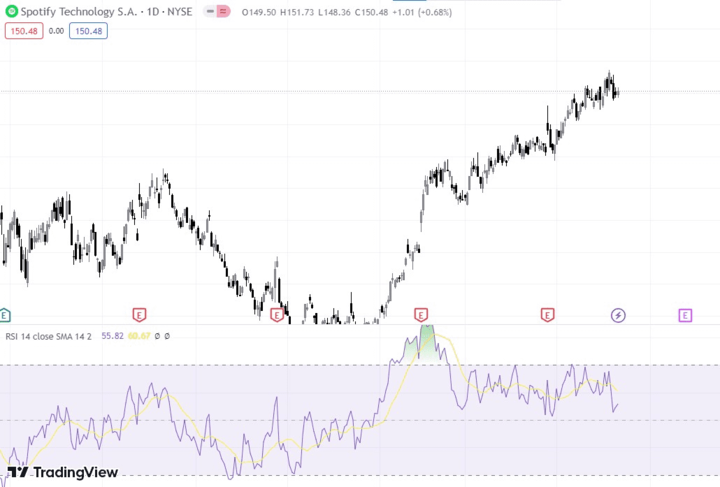
RSI measures the speed and change of price movements, oscillating between zero and 100. An RSI above 70 suggests that the SPOT stock may be overbought (and due for a price drop), while an RSI below 30 suggests it may be oversold (and due for a price increase). Currently, the RSI for SPOT stock suggests it might be oversold.
Bollinger Bands
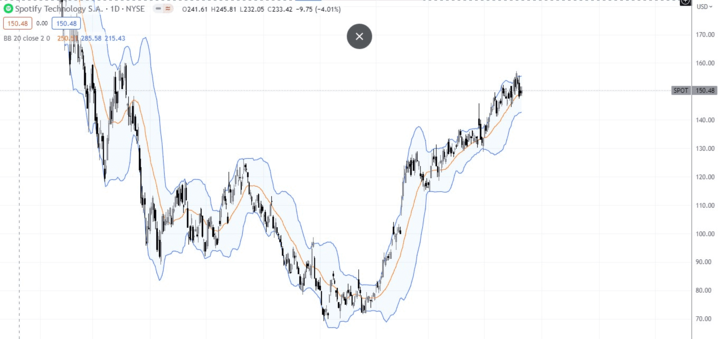
These bands encompass the moving average of SPOT stock, typically two standard deviations away. If the stock price touches the upper band, it may be overvalued; if it touches the lower band, it may be undervalued. Since SPOT stock price is coming off a recent bounce to the upper band, it suggests that price is moving to correct the “oversold” determination.
MACD (Moving Average Convergence Divergence)
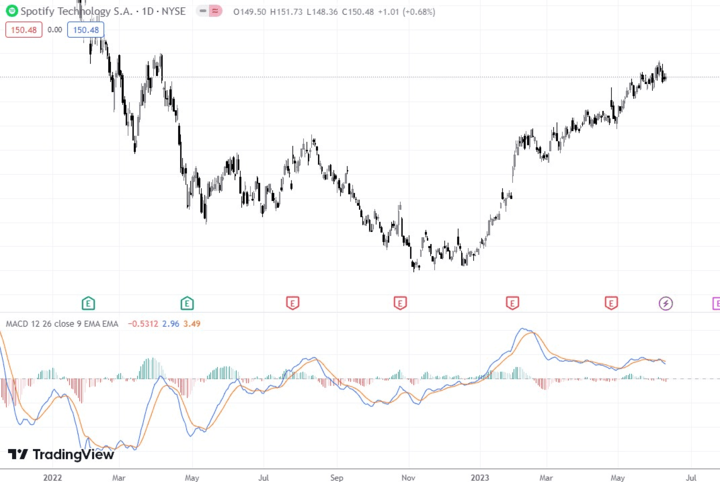
This indicator involves subtracting the 26-day EMA (Exponential Moving Average) from the 12-day EMA. A signal line (the 9-day EMA of MACD) is then plotted on top of the MACD. When the MACD crosses above the signal line, it's a bullish signal; when it crosses below, it's a bearish signal.
The picture above shows the MACD line crossing below the signal line, thus indicating a temporary bearish momentum for the SPOT stock price.
Remember, while technical analysis can provide insights, it's not a guarantee of future performance. It should be combined with other methods like fundamental analysis for a more comprehensive approach to trading.
Tips For Creating A Portfolio That Includes Spotify Stock
Here are some tips for creating a portfolio that includes Spotify stock:
Understand Your Risk Tolerance: As Spotify's stock price can be volatile, it may not be suitable for risk-averse investors. Consider your risk tolerance and invest in Spotify accordingly.
Invest for the Long-Term: Spotify is a growth company with increasing revenues but fluctuating profitability. Consider investing for the long term to ride out short-term market volatility.
Keep an Eye on the Industry: Given that Spotify operates in the highly competitive music streaming industry, staying informed about industry trends and competitors' strategies can help anticipate potential market shifts.
Regularly Review and Rebalance: Review your portfolio to ensure it aligns with your investment goals. Rebalancing can help maintain your desired level of risk and return.
Seek Professional Advice: Before adding Spotify to your portfolio, it may be beneficial to seek advice from financial professionals or use financial planning tools.
Trade SPOT Stock CFD at VSTAR
Ready to trade SPOT stock? If you are, then you’ll need a CFD provider. This is because of all the possible options for trading Spotify stock; CFDs remain the best and the safest. Speaking of CFD providers, one excellent recommendation for you is VSTAR.
Why VSTAR?
Here are a few key advantages you'll enjoy by trading SPOT stock CFDs with VSTAR:
Narrow Spreads: VSTAR ensures you’ll have access to very narrow spreads, thereby decreasing your trading expenses. This means you'll enjoy optimal spreads when trading META stock.
Utilizing Leverage: VSTAR allows you to optimize your SPOT stock trading through leverage, enabling you to open more substantial positions with a smaller upfront investment.
Exceptional Customer Assistance: VSTAR has a committed and responsive support team that is always ready to address your queries, promising an effortless trading journey.
Trading Flexibility: With VSTAR, you can capitalize on both rising and falling prices in SPOT stock, broadening your trading potential.
VSTAR offers a user-friendly app that suits experienced traders as well as newcomers. The app comes with a host of features, including a minimum deposit requirement of just $50, protection from negative balances, real-time access to high-demand markets, and the availability of demo accounts for practicing trades without risk.
Conclusion
All the signs point towards Spotify stock being a very strong buy right now, and although it just came out of a major crash, Spotify stock price is already accelerating back towards profits. Experts all agree that Spotify stock will record great profits over the next three years, so if you haven’t grabbed some SPOT stock for yourself, now may be a good time to do so using VSTAR.
